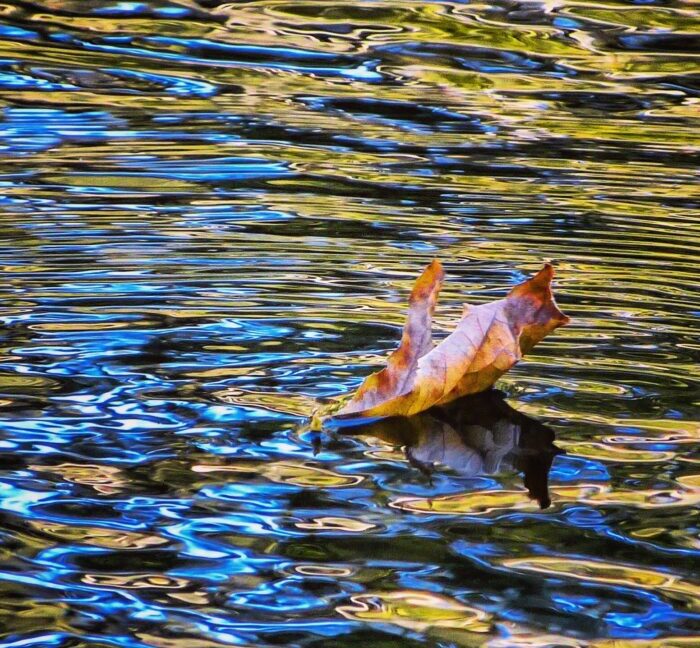Growing up spending time in the Texas Hill Country, I found joy and peace in rivers and creeks. Often seen as symbols of time and life, rivers represent change and flow. As the Greek philosopher Heraclitus said, “No one ever steps in the same river twice, for it is not the same river and s / he is not the same person.”
The pace of change can seem relentless these days. My teacher, Rabbi Zalman Schachter-Shalomi, z”l, liked to say that life is seldom smooth as Lake Placid, but (mostly!) not like going over Niagara Falls in a barrel. It is often more like a flowing river, sometimes calm and sometimes full of rocks and rapids. We don’t get to choose most of the currents that shape our lives, but we have the freedom to paddle among them with the best skill we can muster as we set our course.
Like a river, life is always changing, and being aware of that can make joy more precious and challenges more bearable. Reb Zalman also liked to share the story about King Solomon searching for a ring that could make a happy person sad and a sad person happy. A wise silversmith fashioned a ring with the words ”Gam Zeh Ya’avor,” “This too shall pass.” (Reb Zalman had that printed on a silicone bracelet along with another saying, “Gam Zu Le-Tovah,” “This too is for the best.”)
As a rabbi who finds inspiration and solace in nature as well as ancient texts, I’m here at The Wisdom Daily this summer sharing insights and practices that have helped me and may be useful to others, based around the four ancient elements of earth, water, air, and fire / light. Each and all of these can be ready gateways to foster connection with nature, tradition, and our inner lives. Today, I’m looking at flowing water.
We are living on the water planet. Water covers over 70 percent of the earth’s surface and comprises about 60 percent of our own bodies, bodies that developed in the waters of the womb. Water, Mayim, is one of the most powerful and pervasive forces in Hebrew tradition, appearing as the first element of creation (Genesis 1) and going on to symbolize life and Torah (for example, Jeremiah 17:8). Springing up in the arid landscape of the Land of Israel, our tradition developed prayers for rain and dew and rituals for washing and immersing.
Crossing the modest Jordan River (Joshua 3), our ancestors arrived in the Land of Israel, known primarily as a land of creeks and wadis that flow in the rainy season, a “land of brooks of water” (Deuteronomy 8:7). Rabbi Herbert Weiner suggested that the yearning for rain to fill the rivers of Israel drew our ancestors’ gaze heavenward and influenced our spiritual people’s development.
In Hassidic and mystical thought, a river can be a symbol of the Shefa ![]() —the abundance or flow from God to humanity. There is a sense that if we can serve properly and pray with true intention, we will open the faucet, as it were, to receive the divine flow into the world. Another way to see it is that the flow is always there, but through prayer and meditation we become more conscious and appreciative of it.
—the abundance or flow from God to humanity. There is a sense that if we can serve properly and pray with true intention, we will open the faucet, as it were, to receive the divine flow into the world. Another way to see it is that the flow is always there, but through prayer and meditation we become more conscious and appreciative of it.
Rabbi Avraham Weinberg of Slonim wrote about this spiritual flow in his book Birkat Avraham, which I got to study with the Institute for Jewish Spirituality. Inspired by a passage in the book of Numbers that describes the “nachalim”—the Wadis or creek beds that the Israelites came across in their desert wanderings, the Rebbe explained that there is an “upper stream” from God that is aroused by the “lower stream” of our prayers to flow with love, joy, blessing, and goodness into our lives and consciousness.
Diving deeper into the river, the Sod (mystical) level of their flow is explored in the book The River of Light: Spirituality, Judaism, Consciousness, by Lawrence Kushner. Rabbi Kushner explores the nature of consciousness—the river of light that pervades the cosmos—as perceived in Midrashic myth, theology, and scientific inquiry. He writes, “In Jewish mysticism, the river is a metaphor for the Holy Oneness that unifies all creation. Just imagine it: a sacred stream, luminous and ubiquitous, a river of light.”
Psychology has given us the concept of a “state of flow,” in which our attention and actions become one when we are fully engaged and in the moment. I think it’s doubly powerful when we are in the flow near some actual flowing water! “Blue Spaces” with natural water are known to foster calm, stimulate healing, and foster positive habits.
A Practice for Water
Your ability to connect with Blue Spaces (natural water) obviously depends on a lot of factors, so get creative. Maximally, find a place where you can safely be near or in flowing water. If that’s not available to you, you might seek out a fountain in a park or a water feature in a garden.
Depending on the setting, you might:
- Swim and immerse in the water, like a natural Mikveh, to feel a sense of renewal and refreshment, and to emerge with a kavannah or intention for what you need to feel and do.
- Wade in the water and sense its coolness on your feet and ankles. Wading shoes are good if the ground beneath the water is rocky. Dip your hands in the water and scoop some up like a netilat yadayim, washing and lifting up of the hands. You might choose to take this moment to dedicate your hands to some good work or deed.
- Sit or stroll by the water, watching the play of light on water and trees, breathing the fresh air, listening to the birds. Take some time just to be present and restore yourself. Conclude by sending a blessing from this place out to the world and considering one way that you could share this goodness with others.
- Whatever practice you choose, you might meditate on or repeat the phrase, Mayim Chayim, Waters of Life.
Go with the flow!
Shortly after I wrote this post, my beloved Texas Hill Country was stricken with severe floods that took many lives. To help the affected communities, consider the Kerr County Flood Relief Fund:
https://cftexashillcountry.fcsuite.com/erp/donate/create/fund?funit_id=4201
*Photo taken by Rabbi Julie Hilton Danan, https://wellspringsofwisdom.com

